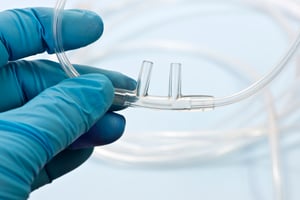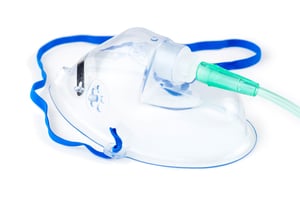How To Keep Your Oxygen Cannula On At Night
What You Should Know: Nasal Cannula and Oxygen Masks
Posted by Erin Lowry on Feb 8, 2019 nine:55:00 AM
Many dissimilar diseases and illnesses may require supplemental oxygen, such as asthma, COPD, cystic fibrosis, pneumonia and sleep apnea are a few that may crave oxygen. Many patients use nasal cannula to receive their supplemental oxygen, only at that place are a few people who prefer or need to apply oxygen masks instead. Nasal cannula is often more comfortable than oxygen masks, and it allows the patient to have more ease talking than they would with a mask. Cannula also takes up less room and tin can help the patient feel less claustrophobic than using a mask. Masks can provide a more constant level of oxygen (commonly a preset amount) and can help control carbon dioxide memory besides every bit supply the patient with oxygen. Oxygen naturally occurs in room air around 21% and anything higher is considered a drug. Too much oxygen can be damaging to the patient's health, and it can result in the patient becoming dependent on high levels of oxygen. Nasal Cannula Nasal cannula is a device that helps deliver oxygen from an oxygen supply source (i.e. oxygen tank, portable oxygen concentrator) to an individual needing oxygen. The lightweight tube has two prongs that fit into the nostrils, wraps backside the ears and attaches the oxygen supply source (i.eastward. an oxygen concentrator or a hospital wall). Common use of nasal cannula in adults can acquit between 1-five liters of oxygen per minute. For those who may demand higher flows of oxygen, nasal cannula tin likewise be high catamenia and deport up to 60 liters of oxygen per infinitesimal. Nasal cannula can make your nostrils dry, but there are attachments that can add together wet and warmth into the air to go far easier to breathe. Cannula is a neat choice for those who need oxygen regularly, but don't want the restriction of a mask. Oxygen Masks Oxygen masks can be either an oral/nasal mask or a full-face up mask. The mask tin exist fabricated out of a few materials, such as plastic, rubber or silicone. Medical oxygen masks are often fabricated out of polymer, as it is soft and somewhat flexible. To hold the mask up, an elastic strap is connected to either side of the mask and so wraps around the patient'southward caput. Boilerplate flow rates for those who utilise a mask is between half-dozen and x liters per infinitesimal, and the oxygen percent ranges from 40% to threescore% oxygen. The minimum of half dozen liters flow charge per unit is required to aid remove the exhaled carbon dioxide to remove through small holes on the side of the mask. A mask is a great option for those who have carbon dioxide retention and need a little bit of help with removing the carbon dioxide. The Risks Every bit with everything, there are risks involved with nasal cannula and oxygen masks. Luckily, the risks are not very severe and are considered low-risk. Mutual issues with nasal cannulas are the abiding nasal dryness, and the risk of high oxygen levels which tin exist damaging to the patient's wellness. There are devices that tin attach to the patient'due south oxygen supply source to add moisture into the air, so the nasal passages are less irritated and dry. It is possible that skin irritation tin can occur with the cannula or a mask, as it can rub against the skin. This tin be remedied by using over-the-counter (or prescribed) ointment that can assist minimize chafing and peel irritation. There is also a risk of fire, as oxygen tin can facilitate combustion. For those that use oxygen, posting signs nearby that say "No Smoking" can aid minimize the possibility of burn. The patient should make sure to go along their oxygen supply source away from aerosols, candles, fireplaces and stoves. Though oxygen has may benefits, there are however severe complications if the patient is not taking the prescribed corporeality. Pulmonary oxygen toxicity can occur when your body is given as well much oxygen, which can issue in pain behind the sternum and fifty-fifty a coughing. The boilerplate oxygen user, who is on a set liter per minute by their doctor, is not at risk for oxygen toxicity. If the patient has been using a higher level of oxygen than prescribed, contact their medico if they notice whatever symptoms, such as a tickle when inhaling, burning when inhaling, a cough, and fever. Futurity Outlook of Cannula & Masks As medicine and science are continuing to advance, at that place is hope for new and more comfy ways to receive oxygen for those who need it. Currently, oxygen therapy can help improve quality of life in many who need supplemental oxygen. This not simply helps amend quality of life, but it can help with their ability to participate in activities, slumber better and fifty-fifty live longer than without oxygen. Supplemental oxygen can also exist prescribed to exist used during sleep or practice, which may crave the use of cannula or a mask to help the patient breathe during this time. Conclusion For those that use oxygen, nasal cannula and oxygen masks are both common methods of delivering oxygen from the supply source. There are benefits of both nasal cannula and oxygen masks, and it is upwards to the doctor and the patient to determine what may exist best for them. There are too many risks of both delivery methods as they can be dissentious for your pare and nasal passages. Pulmonary oxygen toxicity is very dangerous, just if the private is on a prescribed liter per minute and follows it, they have no risk of developing pulmonary oxygen toxicity. Supplemental oxygen is very helpful for many people, providing them with necessary oxygen to go most their daily life.


Source: https://www.1stclassmed.com/blog/what-you-should-know-nasal-cannula-and-oxygen
Posted by: finneysuster1964.blogspot.com


0 Response to "How To Keep Your Oxygen Cannula On At Night"
Post a Comment